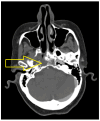Long-Term Survival in Metachronous Primary Malignancies: Stage III Nasopharyngeal Cancer and Stage IV Non-Small-Cell Lung Cancer
- PMID: 40429295
- PMCID: PMC12112175
- DOI: 10.3390/jcm14103299
Long-Term Survival in Metachronous Primary Malignancies: Stage III Nasopharyngeal Cancer and Stage IV Non-Small-Cell Lung Cancer
Abstract
Introduction: The occurrence of a second primary lung cancer after head and neck cancer is a challenge for multidisciplinary teams, since the development of a second lung cancer negatively affects the survival rate of patients with head and neck cancer. Case Presentation: This article presents the case of a patient with a double location of cancer: inoperable stage III nasopharyngeal carcinoma, biopsied in December 2017 (non-keratinizing nasopharyngeal carcinoma), treated by means of radiotherapy and chemotherapy (2018-2021), and stage IV lung cancer (squamous carcinoma) with lung metastases, diagnosed in December 2021, treated using polychemotherapy, subsequent maintenance monochemotherapy, radiotherapy of the thorax, and subsequent maintenance monochemotherapy with a favorable result. The patient was still under treatment as of February 2025, the date of the preparation of the current article. Discussion and Literature Review: Regarding the location of the second metachronous cancer, studies show that the most frequent locations are the lungs and the esophagus, with the main causes being alcohol consumption and smoking. Therefore, these patients should be monitored by screening the respiratory and digestive tracts, especially in men, in order to identify a second cancer, either synchronous or metachronous, in an early stage. Conclusions: Educating the patient with head and neck cancer regarding quitting smoking and cutting out alcohol, as well as conducting a follow-up survey, may reduce the incidence of multiple primaries. Moreover, the multidisciplinary management of second primary lung malignancies in patients with head and neck cancer may lead to long-term disease monitoring.
Keywords: favorable response; long-term survival; lung cancer; metachronous primary cancers; nasopharynx.
Conflict of interest statement
The authors declare no conflicts of interest.
Figures







Similar articles
-
Synchronous and metachronous head and neck carcinomas.Cancer. 1994 Oct 1;74(7):1933-8. doi: 10.1002/1097-0142(19941001)74:7<1933::aid-cncr2820740718>3.0.co;2-x. Cancer. 1994. PMID: 8082099 Review.
-
Outcomes for patients with synchronous and metachronous primary lung cancer after diagnosis of head and neck cancer.Head Neck. 2017 Aug;39(8):1544-1549. doi: 10.1002/hed.24751. Epub 2017 Jun 7. Head Neck. 2017. PMID: 28593651
-
Lung cancer in patients with head and neck cancer. Incidence and long-term survival.Am J Surg. 1987 Oct;154(4):434-8. doi: 10.1016/0002-9610(89)90019-6. Am J Surg. 1987. PMID: 3661848
-
Multiple primary cancer in patients with cancer of the head and neck: second cancer of the head and neck, esophagus, and lung.Int J Radiat Oncol Biol Phys. 1989 Sep;17(3):467-76. doi: 10.1016/0360-3016(89)90096-5. Int J Radiat Oncol Biol Phys. 1989. PMID: 2674075 Review.
-
Second primary lung cancers following a diagnosis of primary head and neck cancer.Lung Cancer. 2015 Apr;88(1):94-9. doi: 10.1016/j.lungcan.2015.01.011. Epub 2015 Jan 23. Lung Cancer. 2015. PMID: 25662386
References
-
- Chen M.-C., Feng I.-J., Lu C.-H., Lin J.-T., Huang S.-H., Lee K.-D. The incidence and risk of second primary cancers in patients with nasopharyngeal carcinoma: A population-based study in Taiwan over a 25-year period (1979–2003) Ann. Oncol. 2008;19:1180–1186. doi: 10.1093/annonc/mdn003. - DOI - PubMed
-
- Warren S., Gates O. Multiple Primary Malignant Tumors: A Survey of the Literature and Statistical Study. Am. J. Cancer. 1932;16:1358–1414.
Publication types
LinkOut - more resources
Full Text Sources

